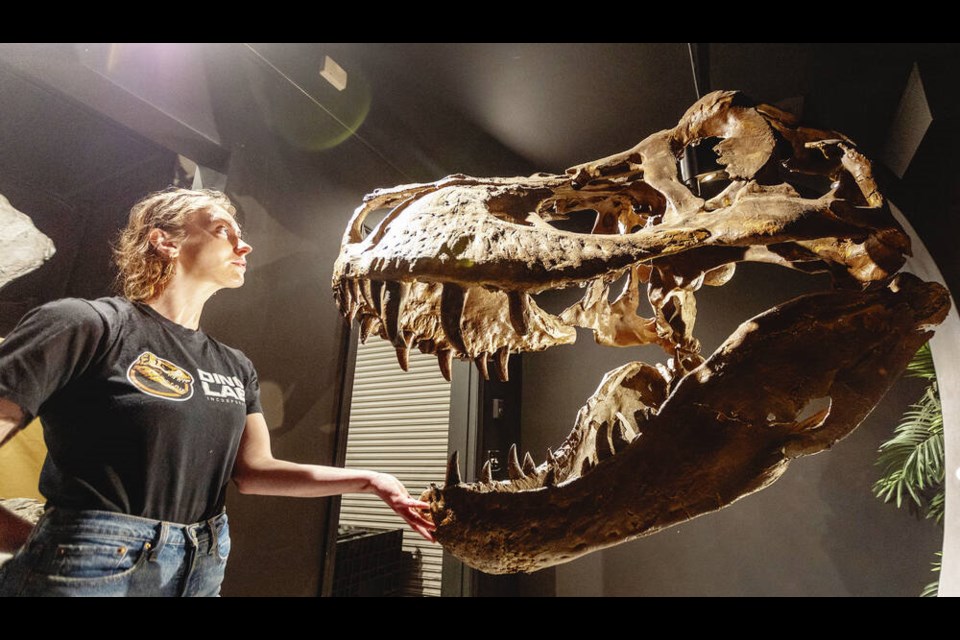Ever held a petrified clump of dinosaur poop?
How about a “murder banana?”
That’s a T. rex tooth, about the same size as the fruit, but 10 times the weight and, honestly, quite thrilling to hold in your hand, imagining the damage it must have done to prey in prehistoric times.
If you believe the theory that an asteroid or meteorites caused the extinction of dinosaurs, you can pick up a small meteorite that crashed to Earth, but be prepared — it’s way heavier that it looks.
Run your hands over a nest of petrified dinosaur eggs, step inside the skull of a triceratops and a T. rex, feel the fang of a sabre-tooth tiger and see how your femur measures up to that of a T. rex. The long, smooth curve of a mammoth tusk may be just what you need today.
Getting hands-on with the specimens is encouraged at Dino Lab, a Victoria company that turns bones into full dinosaur skeletons and has a private museum for public viewing.
It’s been operating out of a building on Dupplin Road in Saanich since 2019, doing work for private collectors and museums. It is now in the process of moving to a bigger space in James Bay. An opening is set for mid-June on Erie Street in the former manufacturing space of Daniel’s Electronics. (The Dupplin Road location is expected to close in May.)
It’s triple the space with high ceilings to hang flying dinosaurs and glassed-in viewing areas for the public to watch technicians work on fossils and build skeletons.
Carly Burbank created a museum out of the specimens she and partner Terry Ciotka have collected over the decades, and offers guided tours and birthday parties where people can touch and examine prehistoric finds — and even get into a lab coat and do some excavating themselves with dentist-drill-type compressors and other tools.
You can step into the cast containing the remains of a perfectly articulated triceratops that had been buried for 66 million years.
The theory is that a big T. rex bit the back end of it, dragged it off and something happened where it became rapidly buried. Raptor teeth in the remains suggest the ferocious little dinos may have been feeding on it.
There’s a baby Tenontosaurus that died 115 million years ago, and is completely intact and embedded in rock.
An adult Tenontosaurus is nearby, exactly the way it was found and arguably one of the most complete dinosaurs anywhere in the world, where you can actually see the tendons on the bones.
“Carly has made something unique in the world where you can actually go into a museum and touch and hold artifacts and I think that’s what brings the whole thing together,” said Ciotka. “In a typical museum, you’re 10 feet back just looking at it.”
Added Burbank: “I went to art school and I was obsessed with stone carvings and I’d go to museums in Europe and I’d say please let me touch.”
There are fragile pieces, she said, but something like a T. rex leg bone you can’t damage, so there’s no reason that kids or anyone else can’t touch it.
Burbank said the Jurassic Park movie franchise has whipped up interest in dinosaurs.
“Dinosaurs have traditionally been marketed to little boys, but seniors like them, women like them. … I wanted something that would spark something in the industry altogether because when I grew up, I didn’t study dinos at all in school. I thought they were like unicorns.”
She said the hope is to spawn the interest of future generations in paleontology and natural sciences.
Dino Lab manager Kalene Lillico, whose dedication to pre-history is obvious in the tattoo of Vancouver Island’s most famous dinosaur, the elasmosaur, on her arm, said visitors are amazed by what’s on display.
“Kids and adults are thrilled, the kids obviously because most love dinos, but the adults, too, because they can understand all of the years of work that goes into it … the years of prep, all the time spent with 3D printing missing pieces, all the painting, all the welding,” she said. “It’s the shock and awe you see on people’s faces when you say you can give this triceratops a little tickle on the nose if you want.”
There is a fee to see the museum and hold special events at the space. Go to dinolabinc.ca for more information.
>>> To comment on this article, write a letter to the editor: [email protected]



